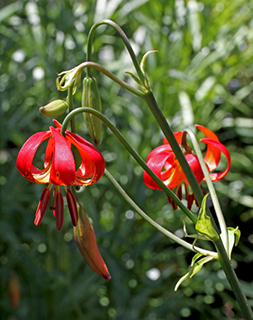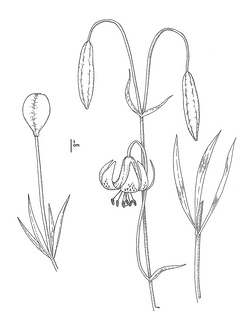(Lilium pardalinum ssp. pitkinense)
 Lilium pardalinum ssp.pitkinense. Photo © Vernon Smith.
Lilium pardalinum ssp.pitkinense. Photo © Vernon Smith.
 Lilium pardalinum ssp.pitkinense. CDFW illustration by Mary Ann Showers. (Click to enlarge)
Lilium pardalinum ssp.pitkinense. CDFW illustration by Mary Ann Showers. (Click to enlarge)
Pitkin Marsh lily is a California endangered plant species, which means that killing or possession of plants collected from the wild is prohibited by the California Endangered Species Act (CESA). Pitkin Marsh lily is a perennial herb that grows three to six feet tall with large flowers that are red on the outside and become yellow with maroon dots at the center. It flowers from June to July and is distinguished from the subspecies L. pardalinum ssp. pardalinum by its shorter petals and anthers. Pitkin Marsh lily only grows in permanently saturated, sandy soils at the edges of marsh wetlands and riparian habitat. Pitkin Marsh lily is also listed as endangered under the federal Endangered Species Act.
When Pitkin marsh lily was federally listed in 1997, it was known to exist at three occurrences in two marshes in Sonoma County, both of which were privately owned. At the time of the U.S. Fish and Wildlife Service’s 5-Year Review (PDF) conducted in 2009, only one of these occurrences was confirmed to exist. This occurrence is under a 19-acre conservation easement held by CDFW, and is managed by a local chapter of the California Native Plant Society. The other two occurrences are located on a privately owned marsh that has not been surveyed since 2001 when the occurrences were last confirmed. A portion of the marsh is owned by the Sonoma Land Trust, which provides a buffer to impacts from development.
The largest threat to the survival of Pitkin Marsh lily is loss and disturbance of habitat resulting from nearby residential development. Even if development does not directly affect occupied habitat, it could cause changes in hydrology and enable encroachment by invasive species. Monitoring of the portion of the marsh owned by the Sonoma Land Trust indicates that it is becoming drier. Developing rural residences, driveways, and agricultural operations such as vineyards could also lead to increases in runoff, nutrient loading, erosion, sedimentation, and changes in soil pH. Although trampling and grazing were previously noted as potential threats, grazing has been removed from the immediate areas surrounding the plant and removing the grazers may have facilitated the establishment of invasive plants. Additional threats include hybridization with other lily species, the inability to self-pollinate, competition with invasive species, and global climate change.
In order to facilitate the survival of Pitkin marsh lily, the two unprotected occurrences and their habitat should be protected and managed. Existing protected areas should be monitored and adaptively managed to address the problems of invasive species, changing hydrology, erosion and nutrient loading. Additionally a conservation seed collection should be maintained at an appropriate facility and a clone bank may also be beneficial because Pitkin Marsh lily can regenerate from bulb scales.
CDFW may issue permits for Pitkin Marsh lily pursuant to CESA, and you can learn more about the California laws protecting Pitkin Marsh lily and other California native plants. Populations of Pitkin Marsh lily occur in CDFW's Bay Delta Region. More information is also available from the U.S. Fish and Wildlife Service Species Profile for Pitkin Marsh lily.
Updated 06/18/2013